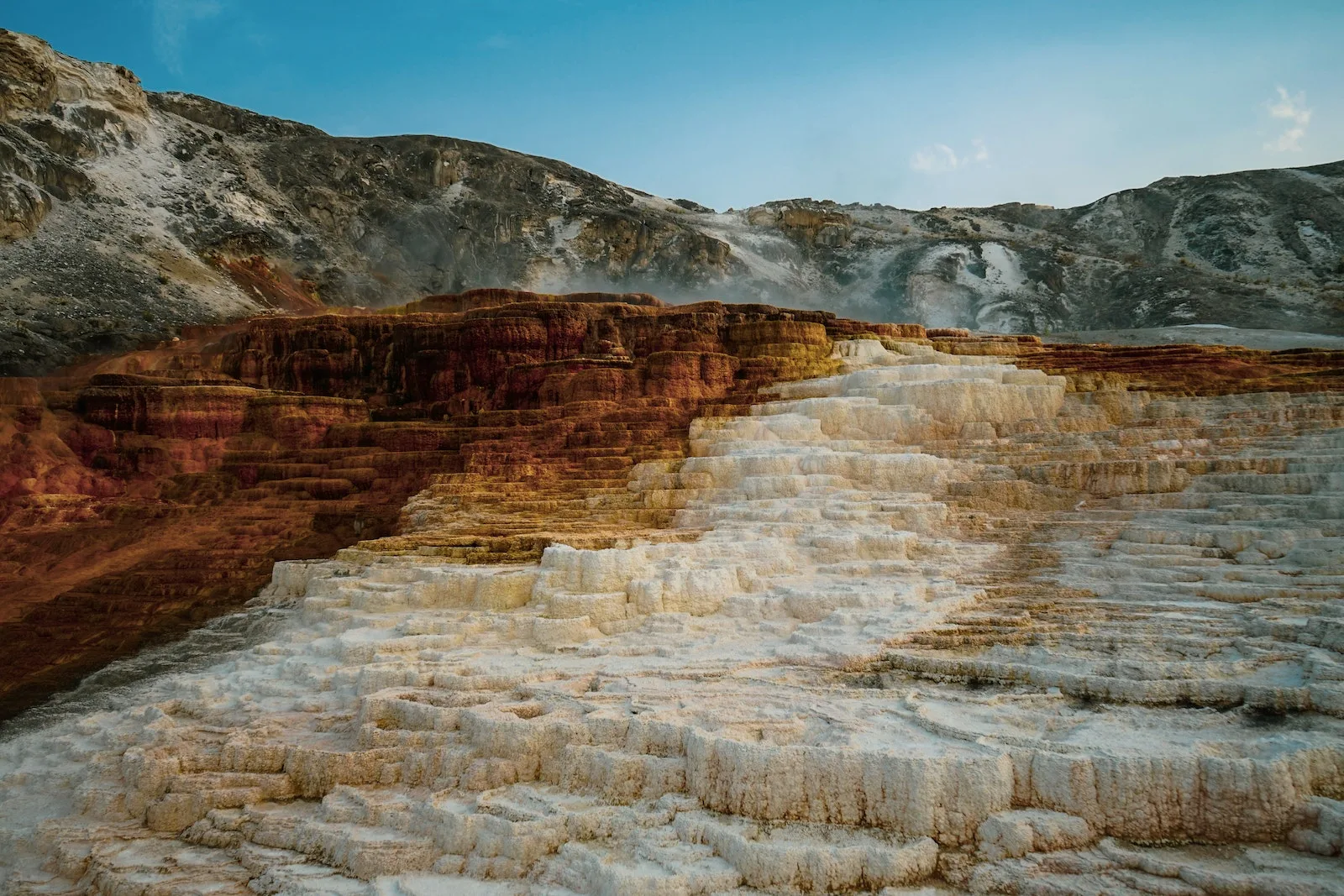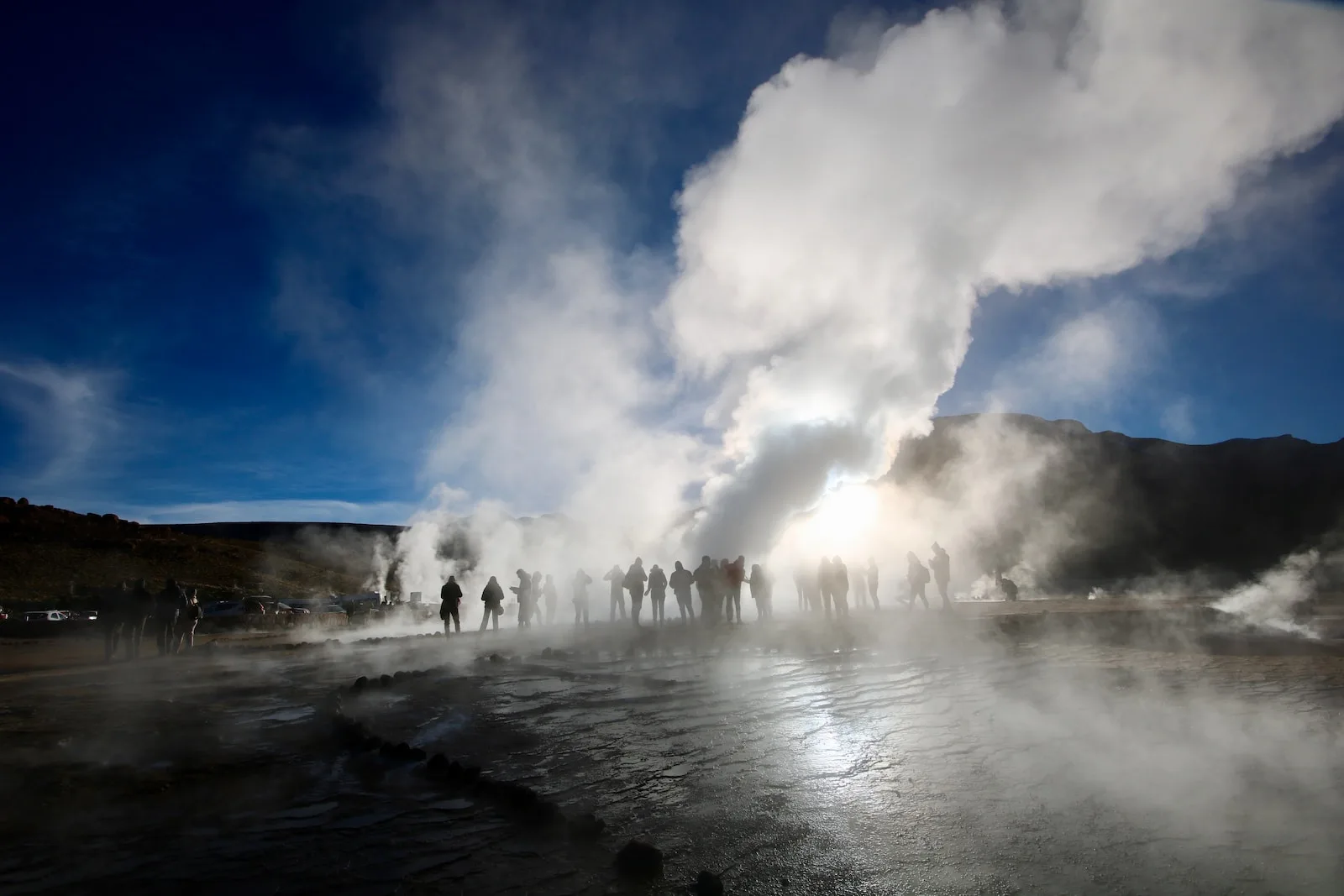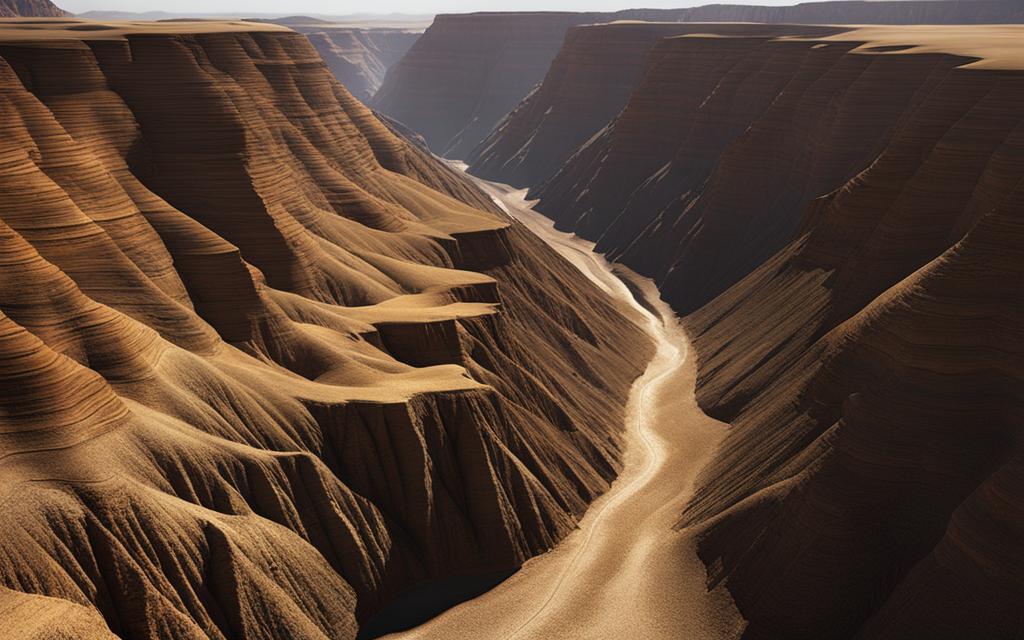Introduction: A Quick Peek at Badlands and Wastelands
Welcome, dear reader, to an intriguing exploration of the enigmatic wonders of Mother Nature – Badlands and Wastelands. At first glance, these terms might seem like synonyms – both suggesting desolate and inhospitable landscapes.
However, as we will soon discover, they are distinct with their own unique characteristics and stories to tell. We embark on this journey by shedding light on each of these terms individually.
Understanding their specific characteristics can help appreciate the stark differences between them. So strap in tight for a fascinating ride through the unchartered terrains of our beautiful planet.
Defining the Badlands: Not as Bad as You Think
The term ‘badland’ is derived from Native American language ‘Mako Sica,’ which translates into ‘land bad.’ French trappers later labeled these lands ‘les mauvais terres à traverser,’ meaning ‘bad lands to cross.’ The terminology might immediately suggest a negative connotation; however, it simply refers to the harsh conditions that make traversing such terrains arduous. Badlands are indeed captivating geological formations characterized by heavily eroded landscapes featuring layers of sedimentary rocks. These sediments often create stunning arrays of colors throughout the terrain due to variations in mineral content.
Iconic examples include South Dakota’s Badlands National Park or Spain’s Bardenas Reales Natural Park. Far from being truly ‘bad,’ they offer unique insights into paleontology and earth’s history.
Wastelands Uncovered: More than Just Waste
Moving onto wastelands, this term typically implies barren areas where little grows due to adverse environmental conditions such as pollution or overuse by humans. Unlike badlands which form naturally over millions of years due to erosion, wastelands usually result from anthropogenic activities disrupting ecological balance or natural disasters rendering an area uninhabitable for most life forms. A prime example is Chernobyl’s Exclusion Zone following one of history’s worst nuclear disasters in 1986.
This area has now become a haunting testament to human error leading to catastrophic environmental damage. However, even within such desolation, nature shows remarkable resilience with wildlife gradually reclaiming these spaces over time – a testament that even in spaces labeled ‘waste’, there can be resurgence and resilience.
The Big Picture: Differences in Formation and Landscape
How Mother Nature Sculpts Badlands
Ever marveled at the rugged beauty of a badland? These unique terrains aren’t the work of an abstract artist but rather, the masterpiece of Mother Nature herself. The formation of badlands is primarily a testament to two natural processes – erosion and deposition.
Erosion, often occurring over millennia, is caused by water and wind wearing away rock layers. Meanwhile, deposition happens when these eroded materials settle down elsewhere, creating layers of different materials.
The fascinating tapestry seen in badlands comes from varying resistance to erosion amongst these layers. Harder layers form protective caps over softer strata below.
As softer material washes away over time, distinctive pinnacles or ‘hoodoos’ are formed with harder rock capping their peaks. The composite minerals also lend their hues to the landscape with iron deposits painting parts red or orange while manganese offers shades of purples and blues.
The Making of a Wasteland: It’s Not All Natural
On the flip side, wastelands aren’t typically born from nature’s grand design; instead, they’re often products of human intervention gone awry. They present cautionary tales where human activities have altered landscapes drastically – so drastically that they become inhospitable for most life forms. An example is deforestation which leads to soil degradation over time and eventually morphs fertile land into a ‘wasteland’.
Industrial pollution too plays its part by contaminating land and rendering it unfit for agriculture or habitation due to toxins seeping into soil or groundwater sources. Of course there are natural wastelands too like deserts where harsh climate conditions make survival difficult – the barren sand dunes stretching far and wide under relentless sun being an iconic image for such terrains.
Life Finds a Way: Comparing Flora and Fauna
The Tenacity of Life in the Badlands: More Than Meets the Eye
Despite the seemingly inhospitable terrain, badlands harbor an impressive variety of life. The flora that inhabit these lands are often hardy and uniquely adapted to withstand dry, nutrient-poor soil conditions.
Sagebrush, rabbitbrush, greasewood, and various species of cacti all find their niche within this challenging environment. These plants boast features like small leaves to minimize water loss and extensive root systems to absorb as much moisture as possible.
Fauna in the badlands are equally resilient. Creatures such as bighorn sheep, pronghorn antelope, mule deer, and coyotes roam these terrains.
Birds like golden eagles, prairie falcons and rock pigeons nest on the rugged cliffs while reptiles such as rattlesnakes and lizards bask in its sun-drenched landscape. Each animal is superbly acclimated to this environment – from possessing specialized skills for climbing steep slopes or surviving on sparse vegetation to withstanding scorching daytime heat.
Surviving Against All Odds: The Unexpected Inhabitants of the Wasteland
In contrast to badlands which form naturally over time through erosion processes, wastelands are often man-made; created through actions such as deforestation or pollution that render a once fertile land barren. Nonetheless life persists here too – albeit differently than within a badland ecosystem.
Wasteland flora is typically comprised of highly tolerant species able to withstand acute environmental stressors. These biological champions include pioneer species like lichens or mosses which can survive even in severely degraded soil conditions.
They perform an essential role by breaking down rock into fertile soil thereby paving path for more complex plant communities over time. As for fauna inhabiting wastelands, extreme adaptability is key for survival.
Insects such as ants and beetles thrive due to their ability to survive harsh environments with little nourishment readily available while rodents like rats emerge victorious thanks to their omnivorous diet and adaptability. To sum it up whilst both wastelands & badlands might appear desolate at first glance they are teeming with life forms – each showcasing unique adaptations that allow them not merely survive but thrive under harsh conditions.
Climate Talks: Weather Patterns and Their Effects
Weathering the Storms in the Badlands
In the badlands, weather patterns are as fascinating as the land itself. Each season presents a distinct face of this raw and rugged terrain. Infamous for their scorching summers, badlands can reach temperatures exceeding 100 degrees Fahrenheit, making them a challenging environment for both wildlife and plant species.
However, it is not just the heat that shapes this landscape. The infrequent yet intense storms play a pivotal role too.
These sudden deluges cause rapid erosion, constantly reshaping the topography of these terrains into intricate lattices of gullies and ravines. This relentless weathering process gives badlands their signature aesthetic – a beautifully chaotic mix of spires, pinnacles and buttes molded by nature’s hand.
When Every Day is a Dry Day in the Wasteland
Moving onto wastelands, these spaces present an entirely different climatic portrait – one dominated by aridity. Wastelands are typically characterized by their exceedingly low rainfall levels, often receiving less than 10 inches per year. With such limited hydration available from above earth’s surface, life in these regions becomes quite challenging.
This extreme dryness has significant implications on soil fertility as well; without enough moisture to support vegetation growth or microorganism activity that enriches soil nutrients, wastelands often transform into barren expanses of sand or rock devoid of lush greenery. But don’t be fooled – beneath this desolate exterior lie stories of profound resilience waiting to be discovered by those who dare to delve deeper.
When Humanity Meets Harsh Terrains: A Tale of Adaptation and Impact
Living on the Edge: Human Settlements in Badlands
Let’s take a stroll through the seemingly inhospitable badlands, where nature has worked overtime to create some of its most spectacular outdoor scenery. Dotted among these landscapes are human settlements that showcase humankind’s tenacity and adaptability.
Life on the edge of badlands is indeed a testament to human resilience. People here have developed innovative ways to sustain themselves amid the rugged topography and volatile weather patterns.
The indigenous Lakota people, for instance, have lived in perfect harmony with South Dakota’s badlands for centuries. These residents harness natural resources like clay and minerals, turning the terrain’s challenges into advantages.
The culture of these communities reflects their environment beautifully. For-instance, Indigenous art from regions near badlands often features striking landforms carved by erosion – a tribute to nature’s wild creativity.
From Thriving to Barely Surviving: Human Impact on Wastelands
Transitioning from the inhabited terrains of badlands, let’s tread towards our next stop – wastelands. Now wastelands are different; they are typically not naturally occurring but rather a product of severe environmental degradation often caused by human activities.
Industrialization, deforestation, unregulated mining – all these factors contribute significantly towards transforming once-thriving ecosystems into barren lands that struggle to support life. A grim example is Central Asia’s Aralkum Desert – once an expansive sea now reduced to a dried-up seabed due to excessive irrigation projects.
Yet despite this bleak picture, humans continue trying to eke out an existence even here—showcasing both our role in creating these harsh conditions as well as our incredible adaptability in surviving them. As we explore these wastelands further, we encounter pockets of brave resilience where life persists against all odds – underscoring the indomitable spirit of survival encoded within every living being.
Cultural Significance & Symbolism of Each Terrain
Badlands in Folklore & Literature: More Than Just Barren Rocks
Contrary to the somewhat pejorative nomenclature, badlands have been a rich source of inspiration in literature and folklore, providing evocative imagery and metaphors. They serve as symbols of raw, untamed wilderness teeming with potential for discovery and adventure.
The ‘wild west’ novels of Louis L’Amour often feature the rugged badlands as a backdrop where tough, taciturn heroes wrestle with their own personal demons while battling nature’s harsh elements. In Native American lore, these lands hold immense spiritual significance.
For instance, the Lakota tribes viewed the South Dakota Badlands as ‘Mako Sica’, or ‘land bad’; however, this term bore more spiritual connotations than outright negative ones. It wasn’t a place to be avoided but rather respected and contemplated; a place where one could connect with the ancestral spirits and essence of Mother Earth.
Wastelands as Cultural Metaphors: Symbols of Desolation & Resilience
While wastelands may evoke images of desolation and abandonment, they are also powerful symbols of resilience and potential rebirth in cultural narratives. They represent places abandoned by civilization or devastated by disaster – natural or man-made – serving as poignant reminders of the consequences of misuse or disregard for our environment. Literature often uses them to explore themes such as societal collapse or post-apocalyptic survival; consider Cormac McCarthy’s ‘The Road’, a grim journey through an ash-covered wasteland that yet subtly hints at hope amid despair; or Margaret Atwood’s ‘MaddAddam Trilogy’ which presents readers with a dystopian view into a future ravaged by genetic manipulation run amok.
Moreover, this seemingly barren terrain also symbolizes human resilience – it is here that seeds quietly germinate under layers of dust ready to transform the desolate landscape given just a sliver chance. Thus serving as metaphors for life’s ability to endure and revive even in harshest circumstances – lending credence to T.S Eliot’s famous line “April is the cruellest month…mixing memory & desire stirring dull roots into Spring rain” from his poem ‘The Wasteland’.
Case Studies: Real World Examples of Both Terrains
The Resilience and Splendor of South Dakota’s Famous Badlands
The Badlands National Park in South Dakota is a stellar example of a badland terrain showing its resilience and breathtaking beauty. Here, the rugged landscape is characterized by towering spires, deep ravines, and layered rock formations.
The wind and water have sculpted these sediments into an array of fantastical shapes – a testament to nature’s artistic prowess over millions of years. Despite the harsh conditions, a surprising diversity of life exists here.
From hardy prairie grasses that grip tightly to the arid soil to animals like bison, pronghorn antelope, and bighorn sheep that have adapted to thrive in this extreme environment. Moreover, this alien-like terrain has been immensely significant for paleontologists finding an abundant deposit of fossils that tell tales from epochs long gone.
The Aralkum Desert: A Harrowing Tale of an Unnatural Wasteland
Moving halfway around the globe brings us to the Aral Sea region in Central Asia – once home to one of the world’s largest lakes but now known more fittingly as the Aralkum Desert – an unnatural wasteland indeed. As a result of severe water mismanagement during Soviet times where expansive irrigation projects drained its lifeline rivers Amu Darya and Syr Darya for cotton cultivation.
In just few decades since 1960s, this waterbody has shrunk by about 90%, leaving behind a desolate desert laden with salt and harmful pesticides – making it inhospitable for most forms of life. A grim reminder that while nature crafts badlands over millennia; human actions can create wastelands within their relatively fleeting lifespan on Earth.
Conclusion: Reassessing Our Views on ‘Bad’ and ‘Waste’ Lands
The Unexpected Beauty of the ‘Bad’
When we think of badlands, the imagery that typically springs to mind is one of bleakness, desolation, and harshness. Yet, delving deeper into these unique terrains reveals a resilience and adaptability that is truly awe-inspiring. The stark beauty of the badlands – their jagged spires and layered rock formations are a testament to nature’s abstract artistry.
The colors that dance across these rugged terrains at dawn or dusk – from fiery reds to soft purples – can stir the soul like no other. Moreover, it’s not just their visual splendor that enchants us; it’s also their ability to support life in such inhospitable conditions.
Each plant and animal species found here have adapted in extraordinary ways to survive and even thrive amidst the constant challenges thrown at them by this severe environment. The next time you come across references or images of badlands, I invite you not just to see them as barren landscapes but rather as arenas showcasing life’s tenacity.
Rethinking ‘Waste’
Similarly with wastelands, we tend to associate them with decay and devastation due to human activities or natural disasters. However, they too tell stories of survival and adaptation – albeit often tinged with sadness due to human-induced factors contributing towards their creation. They serve as stark reminders of man’s impact on nature but also bear witness to nature’s astonishing power for regeneration.
From being discarded lands deemed unfit for habitation or use, several wastelands around the world are now witnessing slow yet steady signs of recovery – either naturally or through human-led rehabilitation efforts. They are evolving landscapes where intricate ecological processes are at work daily towards restoring balance bit by bit.
Wrapping it Up
Both badlands and wastelands challenge our conventional ideas about beauty and value in natural landscapes. It is all about perspective – what may seem desolate at first glance could be teeming with life upon closer inspection; what may feel like an irreversible waste could hold within it seeds for renewal. By re-evaluating our perceptions about these terrains, we can appreciate their unique attributes more fully while driving home lessons about environmental responsibility & resilience which these lands so eloquently embody.
 Skip to main content
Skip to main content


